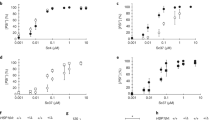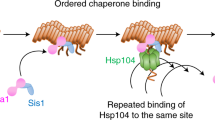Abstract
Key questions regarding the molecular nature of prions are how different prion strains can be propagated by the same protein and whether they are only protein1,2,3. Here we demonstrate the protein-only nature of prion strains in a yeast model, the [PSI] genetic element that enhances the read-through of nonsense mutations in the yeast Saccharomyces cerevisiae4,5. Infectious fibrous aggregates containing a Sup35 prion-determining amino-terminal fragment labelled with green fluorescent protein were purified from yeast harbouring distinctive prion strains. Using the infectious aggregates as ‘seeds’, elongated fibres were generated in vitro from the bacterially expressed labelled prion protein. De novo generation of strain-specific [PSI] infectivity was demonstrated by introducing sheared fibres into uninfected yeast hosts. The cross-sectional morphology of the elongated fibres generated in vitro was indistinguishable from that of the short yeast seeds, as visualized by electron microscopy. Electron diffraction of the long fibres showed the 4.7 Å spacing characteristic of the cross-beta structure of amyloids. The fact that the amyloid fibres nucleated in vitro propagate the strain-specific infectivity of the yeast seeds implies that the heritable information of distinct prion strains must be encoded by different, self-propagating cross-beta folding patterns of the same prion protein.
This is a preview of subscription content, access via your institution
Access options
Subscribe to this journal
Receive 51 print issues and online access
$199.00 per year
only $3.90 per issue
Buy this article
- Purchase on Springer Link
- Instant access to full article PDF
Prices may be subject to local taxes which are calculated during checkout


Similar content being viewed by others
References
Prusiner, S. B. Prions. Proc. Natl Acad. Sci. USA 95, 13363–13383 (1998)
Dickinson, A. G. & Outram, G. W. Genetic aspects of unconventional virus infections: the basis of the virino hypothesis. Ciba Found. Symp. 135, 63–83 (1988)
Weissmann, C. A ‘unified theory’ of prion propagation. Nature 352, 679–683 (1991)
Cox, B. S., Tuite, M. F. & McLaughlin, C. S. The psi factor of yeast: a problem in inheritance. Yeast 4, 159–178 (1988)
Wickner, R. B. [URE3] as an altered URE2 protein: evidence for a prion analog in Saccharomyces cerevisiae. Science 264, 566–569 (1994)
Ter-Avanesyan, M. D., Dagkesamanskaya, A. R., Kushnirov, V. V. & Smirnov, V. N. The SUP35 omnipotent suppressor gene is involved in the maintenance of the non-Mendelian determinant [PSI+] in the yeast Saccharomyces cerevisiae. Genetics 137, 671–676 (1994)
King, C.-Y. Supporting the structural basis of prion strains: induction and identification of [PSI] variants. J. Mol. Biol. 307, 1247–1260 (2001)
Skerra, A. & Schmidt, T. G. Use of the Strep-Tag and streptavidin for detection and purification of recombinant proteins. Methods Enzymol. 326, 271–304 (2000)
Dickinson, A. G. et al. Extraneural competition between different scrapie agents leading to loss of infectivity. Nature 253, 556 (1975)
Maddelein, M. L. & Wickner, R. B. Two prion-inducing regions of Ure2p are nonoverlapping. Mol. Cell. Biol. 19, 4516–4524 (1999)
Chernoff, Y. O., Lindquist, S. L., Ono, B., Inge-Vechtomov, S. G. & Liebman, S. W. Role of the chaperone protein Hsp104 in propagation of the yeast prion-like factor [PSI+]. Science 268, 880–884 (1995)
Kushnirov, V. V. & Ter-Avanesyan, M. D. Structure and replication of yeast prions. Cell 94, 13–16 (1998)
Sparrer, H. E., Santoso, A., Szoka, F. C. & Weissman, J. S. Evidence for the prion hypothesis: induction of the yeast [PSI+] factor by in vitro-converted Sup35 protein. Science 289, 595–599 (2000)
Chernoff, Y. O., Derkach, I. L. & Inge-Vechtomov, S. G. Multicopy SUP35 gene induces de-novo appearance of psi-like factors in the yeast Saccharomyces cerevisiae. Curr. Genet. 24, 268–270 (1993)
Derkatch, I. L., Chernoff, Y. O., Kushnirov, V. V., Inge-Vechtomov, S. G. & Liebman, S. W. Genesis and variability of [PSI] prion factors in Saccharomyces cerevisiae. Genetics 144, 1375–1386 (1996)
Liebman, S. W. Progress toward an ultimate proof of the prion hypothesis. Proc. Natl Acad. Sci. USA 99, 9098–9100 (2002)
Tuite, M. F. & Cox, B. S. Propagation of yeast prions. Nature Rev. Mol. Cell. Biol. 4, 878–890 (2003)
Uptain, S. M., Sawicki, G. J., Caughey, B. & Lindquist, S. L. Strains of [PSI+] are distinguished by their efficiencies of prion-mediated conformational conversion. EMBO J. 20, 6236–6245 (2001)
Liu, J.-J., Sondheimer, N. & Lindquist, S. L. Changes in the middle region of Sup35 profoundly alter the nature of epigenetic inheritance for the yeast prion [PSI+]. Proc. Natl Acad. Sci. USA 99, 16446–16453 (2002)
Way, M., Pope, B., Gooch, J., Hawkins, M. & Weeds, A. G. Identification of a region in segment 1 of gelsolin critical for actin binding. EMBO J. 9, 4103–4109 (1990)
Studier, F. W., Rosenberg, A. H., Dunn, J. J. & Dubendorff, J. W. Use of T7 RNA polymerase to direct expression of cloned genes. Methods Enzymol. 185, 60–89 (1990)
Sherman, F. Getting started with yeast. Methods Enzymol. 194, 3–21 (1991)
Harashima, S., Takagi, A. & Oshima, Y. Transformation of protoplasted yeast cells is directly associated with cell fusion. Mol. Cell. Biol. 4, 771–778 (1984)
Rose, M. D., Price, B. R. & Fink, G. R. Saccharomyces cerevisiae nuclear fusion requires prior activation by alpha factor. Mol. Cell. Biol. 6, 3490–3497 (1986)
Wischik, C. et al. Structural characterization of the core of the paired helical filament of Alzheimer disease. Proc. Natl Acad. Sci. USA 85, 4884–4888 (1988)
Baxa, U. et al. Architecture of Ure2p prion filaments. J. Biol. Chem. 278, 43717–43727 (2003)
Serio, T. R. et al. Nucleated conformational conversion and the replication of conformational information by a prion determinant. Science 289, 1317–1321 (2000)
Acknowledgements
We thank D. L. D. Caspar for support, suggestions and assistance with the manuscript, and C. Long and B. Patel for reviewing the manuscript. This work was supported by an NIH grant to D. L. D. Caspar and an NIH Research Service Award to C.-Y.K.
Author information
Authors and Affiliations
Corresponding author
Ethics declarations
Competing interests
The authors declare that they have no competing financial interests.
Supplementary information
Supplementary Figure 1
His5-Sup35(1-61)-GFP-Strep(II) samples analysed by SDS-polyacrylamide gel electrophoresis. (PDF 177 kb)
Supplementary Figure 2
The morphology of protein aggregates spontaneously formed in His5-Sup35(1-61)-GFP-Strep(II) solutions. (PDF 212 kb)
Supplementary Table 1
Strain-specific transformation by [PSI] particles. (PDF 117 kb)
Supplementary Table 2
Competition among [PSI] strains. (PDF 110 kb)
Supplementary Table 3
Proteinaceous nature of [PSI]. (PDF 113 kb)
Rights and permissions
About this article
Cite this article
King, CY., Diaz-Avalos, R. Protein-only transmission of three yeast prion strains. Nature 428, 319–323 (2004). https://doi.org/10.1038/nature02391
Received:
Accepted:
Issue Date:
DOI: https://doi.org/10.1038/nature02391
This article is cited by
-
MIL-CELL: a tool for multi-scale simulation of yeast replication and prion transmission
European Biophysics Journal (2023)
-
Innate immunity to prions: anti-prion systems turn a tsunami of prions into a slow drip
Current Genetics (2021)
-
A complete catalog of wild-type Sup35 prion variants and their protein-only propagation
Current Genetics (2020)
-
Fibril formation and therapeutic targeting of amyloid-like structures in a yeast model of adenine accumulation
Nature Communications (2019)
-
Nanostructural Differentiation and Toxicity of Amyloid-β25-35 Aggregates Ensue from Distinct Secondary Conformation
Scientific Reports (2018)
Comments
By submitting a comment you agree to abide by our Terms and Community Guidelines. If you find something abusive or that does not comply with our terms or guidelines please flag it as inappropriate.



